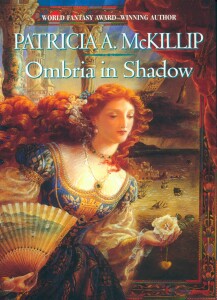 Tracy Willans wrote this review.
Tracy Willans wrote this review.
I love Patricia McKillip’s work. I think I’d better state the obvious early, so my bias is known from the beginning. I revel in the lushness of her language. I love to read it out loud so I can feel the words in my mouth. I am a visual artist, and when I read I see pictures in my head. I believe that these two factors contribute to my love of this particular author and other favourites such as Charles de Lint. It is just a pleasure to read books by authors who have an obvious love for and wonderful command of the English language.
I also find that the second reading of a McKillip is more rewarding than the first, as there is time to linger and more fully appreciate the words because you are now no longer rushing to find out where the story will lead you.
This particular story is set in the long ago of sailing ships and court intrigues with which many readers of fantasy will be quite familiar. A king has died, in less than auspicious circumstances. He leaves behind a young son, Kyel, too young to be king in his own right. Kyel will need a regent, someone to rule in his place until he is old enough to rule – preferably someone with his best interests at heart. Who really cares about him?
His bastard half brother Ducon, born a bastard with no knowledge of who his father is? Ducon must make a choice to accept the offer to take the throne for himself or to preserve it for his young brother. But his first love, and perhaps his downfall, is his love of drawing. All his drawings are of his beloved city, a city that not everyone sees.
Lydea, the tavern wench who became the king’s mistress? Does she truly care for the young prince? How much will she risk to save Kyel, Ducon, herself? Or does she too have a hidden agenda?
What about Black Pearl, his ancient great-aunt, a woman who appears to have lived forever, and certainly not by any natural means?
There are other intriguing characters in this novel. There is Faey, a sorceress who never has the same face twice; sometimes it even changes while you watch. Why does she never leave the safety of the underworld of the city? There’s Mag, the waxling, she who can slip from one side of the city to the other without being detected, who can move from shadow to light and between the under and over worlds without any trouble. Just how human is she?
This is a wonderful story with many intriguing characters who are much more than they appear to be. Not least among them is the city itself, a city that hides and holds its own secrets, a city that shifts and changes. A city of stairs that lead nowhere, of half-seen glimpses through hidden doorways, a shadow city that overlays this city. What is the origin and what does it mean, this story of a change, when the shadow city becomes real and the real becomes shadow? What is the catalyst, or who?
This book is a must for lovers of the work of McKillip, and definitely worth a look for anyone interested in the fairy tale style of story. And me – I’m off to read it again so I can revel a bit more.
(Ace Books, 2002)
